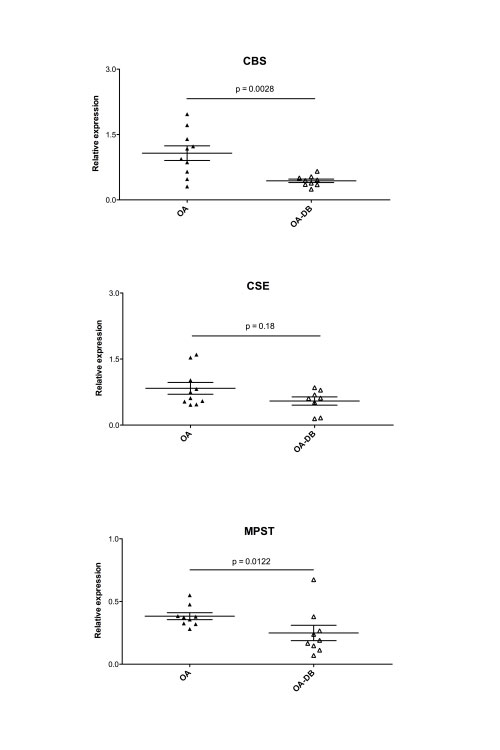Session Information
Session Type: Poster Session (Tuesday)
Session Time: 9:00AM-11:00AM
Background/Purpose: A growing number of findings indicates that type 2 diabetes is an independent risk factor of osteoarthritis (OA). However, the mechanisms underlying the connection between both diseases remain unclear. Hydrogen sulfide (H2S) plays an important role in the pathogenesis of diabetes and its complications. In relation, we and other authors have observed a protective impact of H2S induction on activation of pathological pathways in osteoarthritic chondrocytes. In this study we examined the modulation of H2S levels in serum and chondrocytes from OA/non-OA diabetic (DB) or non-diabetic (non-DB) patients and in cell under glucose stress, in order to elucidate whether impairment in H2S-mediated signaling could participate in the onset of diabetes-related OA.
Methods: Serum and chondrocytes were isolated from OA/non-OA cartilage of diabetic (DB) or non-diabetic (non-DB) patients. Serum levels of H2S were measured by an ion-selective microelectrode. Primary chondrocytes and T/C28a2 were stimulated w/o IL-1β (5 ng/mL) under a normal (5.5 mM; NG) or a high (25 mM; HG) glucose environment. Gene and protein expression of enzymes involved in H2S synthesis (cystationine γ-liase [CSE], cystationine β- synthase [CBS], and 3-mercaptopyruvate sulfurtransferase [3-MT]) and heme oxygenase 1 (HO-1) were assessed by RT-qPCR and WB, respectively. To determine the involvement of H2S in catabolic pathways activated by HG in chondrocytes, NaSH and GYY 4137 (500 μM), a fast and slow-releasing H2S donor respectively, were employed.
Results: H2S levels in serum from OA-DB patients were significantly lower than in those from non-OA-DB patients (p< 0.05). Likewise, fresh isolated chondrocytes from OA cartilage of diabetic patients showed lower levels of H2S synthesizing enzymes (CSE, CBS and 3-MT) than those of non-DB patients (Figure 1). T/C28a2 cells exposed to HG stress expressed lower mRNA and protein levels of these 3 enzymes after 3 days of incubation than in those incubated in NG conditions (0.41- fold and 0.83-fold [CSE], 0.42-fold and 0.66-fold [CBS], and 0.52-fold and 0.79-fold [3-MT] for mRNA and protein expression, respectively; n=6, p< 0.05). Similar results were found in primary chondrocytes incubated in HG in the presence of IL-1β (p< 0.05). Additionally, the expression of IL-6 and COX-2 induced by IL-1β was significantly higher in primary chondrocytes under HG than NG condition (n=5, p< 0.05); whereas protein levels of anti-oxidant enzyme HO-1 were reduced in HG exposed cells. GYY 4137 and NaSH co-treatment recovered HO-1 expression and attenuated IL-6 and COX-2 expression in cells under HG+IL-1β condition (n=3; p< 0.05).
Conclusion: The results indicate a reduction of H2S synthesis as a critical feature involved in hyperglucidic-mediated dysregulation of articular chondrocytes. The impairment of H2S signaling could participate in the mechanisms underlying the predisposition to OA development in diabetic individuals and may open new opportunities for treating patients with a diabetes-related OA phenotype.
To cite this abstract in AMA style:
Vaamonde-García C, Hermida-Gómez T, Blanco F, Burguera E, Meijide-Faílde R. The Synthesis of Hydrogen Sulfide Is Impaired in Osteoarthritic Chondrocytes from Diabetic Patients and in Vitro in Cells Under High Glucose Environment [abstract]. Arthritis Rheumatol. 2019; 71 (suppl 10). https://acrabstracts.org/abstract/the-synthesis-of-hydrogen-sulfide-is-impaired-in-osteoarthritic-chondrocytes-from-diabetic-patients-and-in-vitro-in-cells-under-high-glucose-environment/. Accessed .« Back to 2019 ACR/ARP Annual Meeting
ACR Meeting Abstracts - https://acrabstracts.org/abstract/the-synthesis-of-hydrogen-sulfide-is-impaired-in-osteoarthritic-chondrocytes-from-diabetic-patients-and-in-vitro-in-cells-under-high-glucose-environment/

